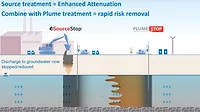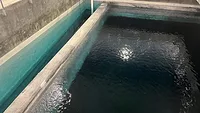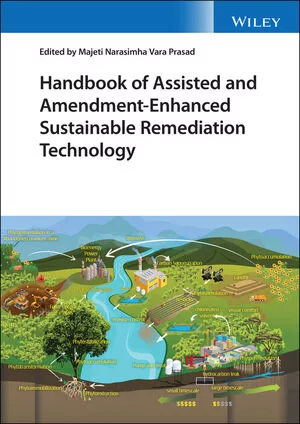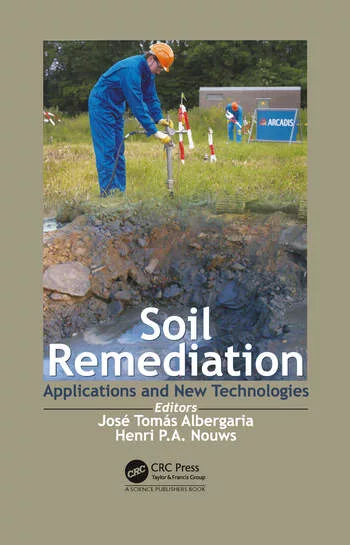Colloidal activated carbon reduces PFAS leaching at source zone by 10x compared to Granular Activated Carbon
Colloidal activated carbon SourceStop reduces total PFAS leaching by more than 10x compared to powdered activated carbon.
.webp?t=1720617286)
Image courtesy of REGENESIS
Each day new PFAS sources are discovered, creating the need for an effective remedy to prevent exposure to the toxic 'forever chemicals.' A new, patent-pending colloidal activated carbon technology meets this demand, containing PFAS at the source with unmatched efficiency to reduce PFAS exposure risk and environmental liabilities.
According to the United States Environmental Protection Agency (US EPA), “approximately 120,000 facilities subject to federal environmental programs have operated or currently operate in industry sectors with processes that may involve handling and/or release of PFAS.” Each of these facilities represents a potential source of PFAS contamination.
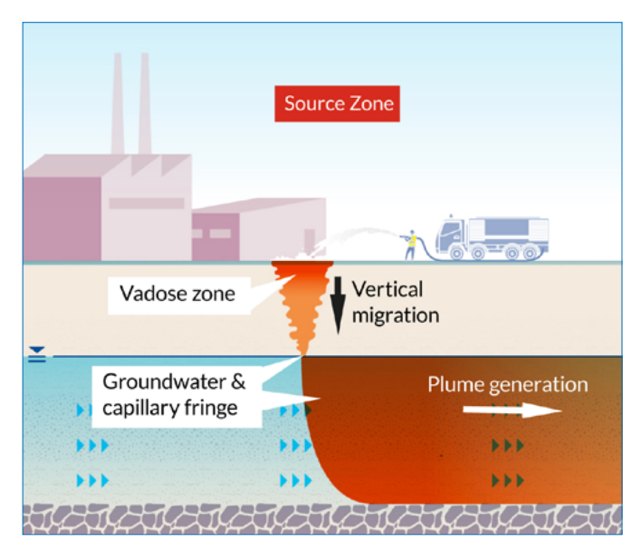
Among the most abundant and problematic PFAS sources are fire pits and other areas where aqueous film-forming foams (AFFF) were used during routine firefighting training drills or Class B firefighting system testing. The repeated AFFF discharges in these areas have formed significant reservoirs of highly concentrated PFAS mass. Precipitation contact with these PFAS source zones causes the chemicals to leach, moving vertically through the soil vadose zone until reaching groundwater.
Once in groundwater, PFAS can form extensive plumes that present significant environmental risks and liabilities. The more widespread groundwater plumes become, the greater the potential to impact downgradient public and private drinking water wells.
When drinking water becomes contaminated, remedial options are necessarily limited to aboveground filtration systems that generate vast quantities of PFAS-laden materials and are extremely costly to install and operate. Consequently, to avoid further impacts to drinking water and human health, it is imperative to identify and remediate the source zones as quickly and effectively as possible, using methods that do not generate large capital expenditures, greenhouse gas emissions, and PFAS-laden wastes.
Stopping PFAS Leaching to Prevent Groundwater Plume Development and Exposure Risk
Since groundwater plumes are fueled by contaminant flux away from the source zone, mainly controlled by leaching, stopping PFAS leaching at identified PFAS source zones should be prioritized and pursued aggressively. Industry-leading material scientists have developed a new, concentrated colloidal activated carbon (CAC) technology to meet this critical need. The CAC material is comprised of activated carbon particles milled to the size of red blood cells (less than 2 microns) and made into liquid form. It is applied directly to the subsurface at the base of a PFAS source zone treatment, forming a horizontal barrier that prevents PFAS leaching and groundwater plume development.
Laboratory Study Demonstrates 10x Improvement with CAC Technology
SourceStop's minute particle size and colloidal form make it far more effective at reducing PFAS leaching than other commodity sorbents, with one laboratory study demonstrating more than a 10x improvement in reducing total PFAS leaching compared to powdered activated carbon (PAC).
Experiment Showing SourceStop’s Effectiveness at Preventing PFAS Leaching
In controlled experiments simulating periods of heavy rainfall totaling more than 100 inches over the study, SourceStop reduced the total PFAS leaching by more than 10x compared to PAC. Most importantly, even greater improvements were observed for the more highly toxic and intensely scrutinized compounds PFOS and PFOA, with leaching reduced by 33x and 62x, respectively, compared to PAC.
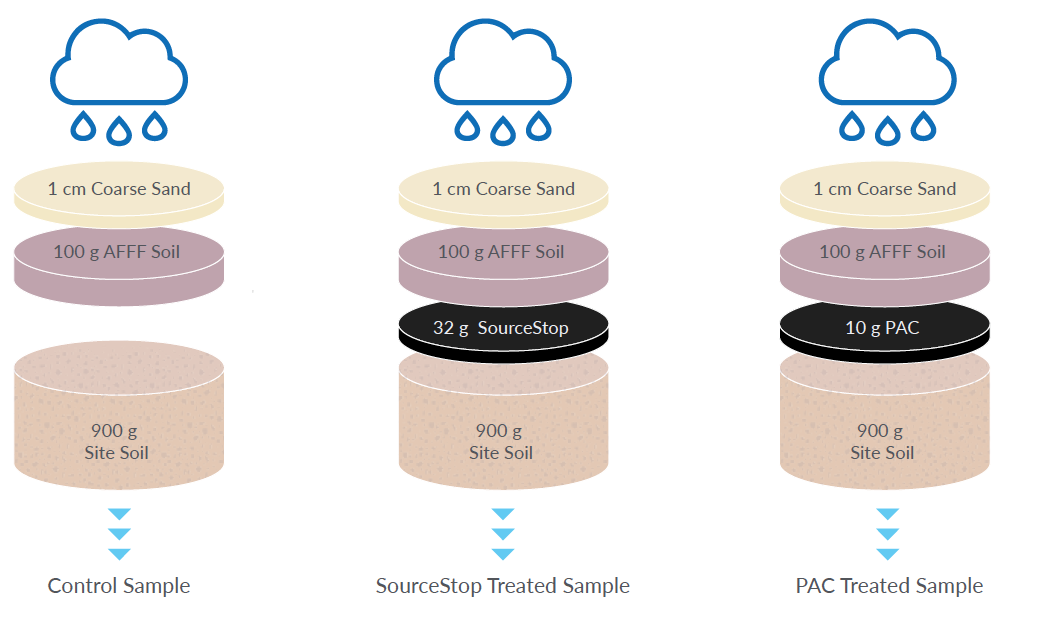
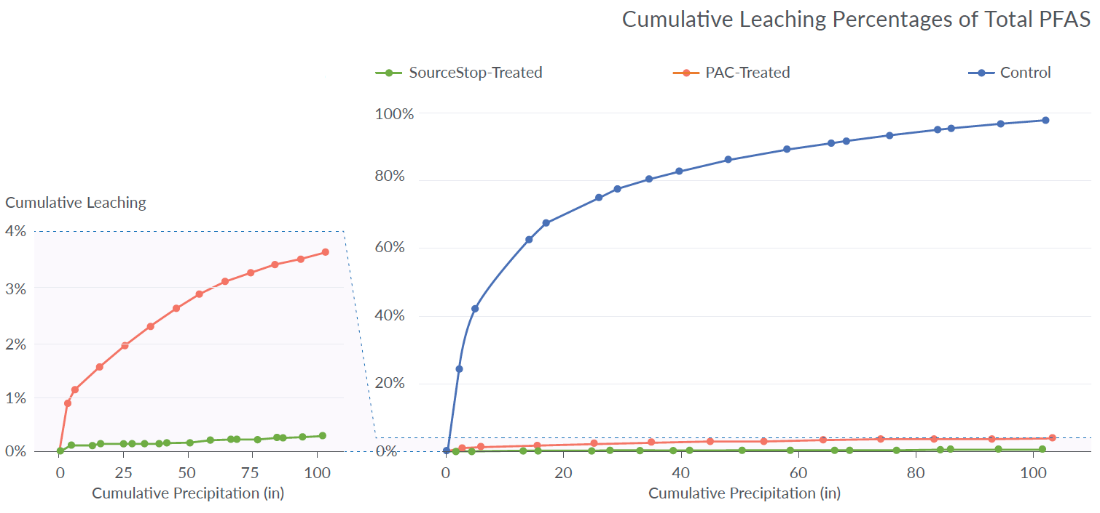
Combining PFAS Source Zone and Groundwater Plume Treatments
The most optimized source zone treatments incorporating SourceStop might also include in situ mixing of soil stabilization and solidification amendments (e.g., Portland cement, additional adsorbents) in near-surface soils or surface capping (e.g., concrete, asphalt, compacted clays) to reduce soil permeability. These near-surface treatments, frequently used at landfills and other waste management sites, divert infiltrating rainwater from contacting highly concentrated PFAS, further strengthening source zone treatment effectiveness.
At sites where groundwater plumes have already formed, PFAS source zone treatments are combined with engineered CAC barriers that cut off plume movement. These permeable reactive barrier systems incorporate PlumeStop®, a patented CAC technology that filters PFAS out of solution in situ, typically for decades for a single treatment. PlumeStop has been used for almost a decade to treat over 400 contaminated groundwater sites with unmatched success, including over 30 PFAS treatments installed worldwide.
The combination of remedies creates a highly effective PFAS source-plume treatment system that can approximate a permanent solution (i.e., decades to centuries) to mitigate the risk of PFAS environmental and human exposure. Additionally, for qualifying sites, the PFAS source-plume treatment system is backed by the industry’s only performance warranty program for the in situ treatment of PFAS. PlumeShield® offers risk-free assurance to project stakeholders that the remediation effort will achieve the performance goals.
Proactively Treating PFAS Source Zones is Necessary to Prevent Unnecessary Exposures
PFAS source zones will continue to be discovered with increasing frequency in the coming years as the US EPA and similar international organizations establish regulations and guidance for addressing PFAS in the environment. A recent EPA internal memo directing the Office of Water to use the National Pollutant Discharge Elimination System (NPDES) permitting process to identify PFAS sources is expected to accelerate this process.
Groundwater industry experts suggest that enhancing PFAS retention in the subsurface "can play an important role in reducing PFAS mass flux and providing long‐term protection of downgradient groundwater receptors."
Advanced CAC materials, which eliminate source contribution to PFAS groundwater plumes and halt further plume migration, have proven to be highly effective enhanced attenuation remedies. Over time, these targeted CAC treatments will reduce further drinking water impacts and potential adverse health effects due to PFAS. Proactively addressing PFAS source zones will ensure that it happens sooner rather than later.

.webp?height=96&t=1666647051&width=96)
.webp?height=96&t=1666659971&width=96)
